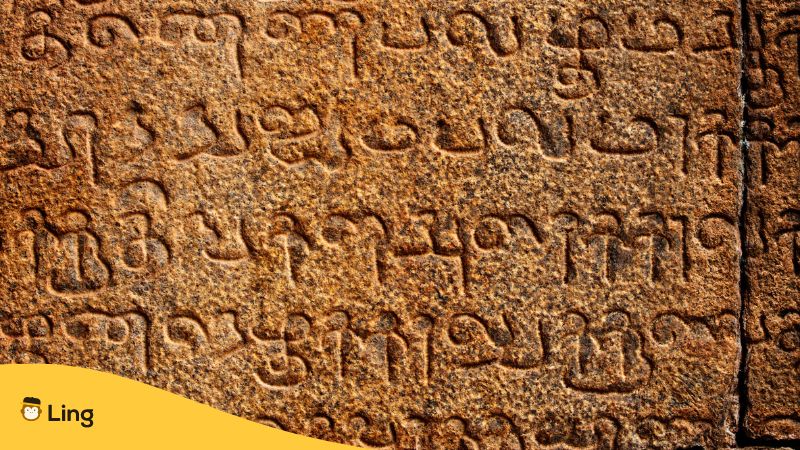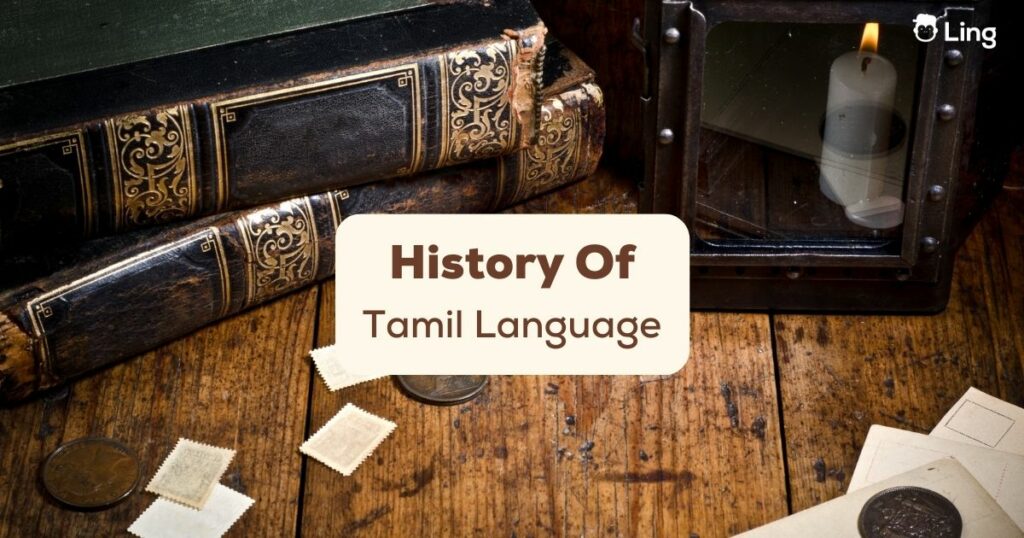Hey there, did you know that Tamil (தமிழ்) is the language of the gods? Well, not really, but it is one of the oldest surviving languages in the world. The history of the Tamil language goes back over 2,000 years. That’s right, 100 times older than my grandma’s dusty, old cookbook! With over 70 million native speakers, Tamil is also one of the most widely spoken languages in the world.
So, if you’re a fan of spicy curries, colorful culture, and a language that’ll make your tongue dance, then buckle up because we’re going on an exhilarating ride through the history (Varalāṟu – வரலாறு) of the Tamil language!

Tamil: Classification And Origins
Tamil is one of the classical languages of the world. This Indian language is part of the Dravidian language family, which includes other Dravidian languages, such as Telugu, Kannada, and Malayalam, spoken in the southern regions of the country.
Within the Dravidian language family, Tamil is classified as a Southern Dravidian language (Teṉ tirāviṭa moḻi – தென் திராவிட மொழி). This classification is based on the geographical distribution of the language and the unique linguistic features that distinguish it from other Dravidian languages. Southern Dravidian languages are spoken primarily in the southern regions of the Indian subcontinent, such as the states of Tamil Nadu, Kerala, Karnataka, and Puducherry in India, as well as in Northern Sri Lanka and Singapore.
The origins of the Tamil language are shrouded in mystery, but it is believed to have evolved from a proto-Dravidian language spoken by ancient people in the region. The early history of the Tamil language can be traced back to the Sangam period, which spanned from the 3rd century BCE to the 3rd century CE. During this period, Tamil was used extensively in literature, poetry, and religious texts, and the spoken language underwent significant changes in grammar and vocabulary.

The Fascinating History Of Tamil Language
In this article, we will take a closer look at the evolution of ancient Tamil through its three major periods of change: Old Tamil, Middle Tamil, and Modern Tamil.
Old Tamil (Paḻaiya tamiḻ – பழைய தமிழ்), also known as Sangam Tamil, is the earliest known form of Tamil, dating back to around 450 BCE to 700 CE. During this period, the Tamil people were organized into three kingdoms: Chera (Cēra cāmrājyam – சேர சாம்ராஜ்யம்), Chola (Cōḻa cāmrājyam – சோழ சாம்ராஜ்யம்), and Pandya (Pāṇṭiya pēraracu – பாண்டிய பேரரசு). It was also the time when the Sangam literature, a collection of Tamil poems and songs, was produced. Old Tamil is characterized by its unique grammar, which included the use of case endings, verb conjugations, and noun inflections. This grammar was used to express complex ideas and emotions, and the language was used extensively in literature, trade, and religious texts.
Middle Tamil (Naṭuttara tamiḻ – நடுத்தர தமிழ்), which spanned from the 7th to the 16th century, saw significant changes in Tamil grammar and vocabulary. During this period, the Chola dynasty rose to prominence, and Tamil literature flourished under their patronage. Middle Tamil was marked by the decline of case endings, the emergence of a more analytic syntax, and the simplification of verb conjugations. This period also saw the introduction of Sanskrit words, which enriched the Tamil vocabulary (Tamiḻ coṟkaḷañciyam – தமிழ் சொற்களஞ்சியம்) and gave rise to a unique form of Tamil-Sanskrit hybrid language called Manipravalam.
Modern Tamil (Navīṉa tamiḻ – நவீன தமிழ்), which began around the 16th century, saw the consolidation of Tamil as a literary language and the emergence of standard dialects. During this period, the Vijayanagara Empire ruled over the Tamil-speaking regions of South India, and the language underwent further changes to adapt to the changing social and political landscape. Modern Tamil is characterized by its simplified grammar, the use of loanwords from European languages, and the adoption of a standardized script.
Despite the changes in grammar and vocabulary over the centuries, Tamil has remained a vibrant and dynamic language with a rich cultural heritage. It is a language that has contributed significantly to the fields of literature, science, and philosophy and continues to be a source of pride and identity for the Tamil people.

Colloquial Tamil Vs. Literary Tamil
The Tamil language has two main variants, spoken Tamil and literary Tamil. The colloquial spoken Tamil is the form of the language that is spoken in everyday conversations and is used in informal settings. This variant of Tamil has evolved naturally over time and has adapted to the changing social and cultural norms of the Tamil-speaking regions. It is characterized by its simplified grammar, the use of regional dialects, and the inclusion of loanwords from other languages.
On the other hand, literary Tamil is the formal written Tamil used in literature, academic writing, and formal settings. It follows strict grammatical rules and syntax and is more standardized than spoken Tamil. Literary Tamil is used in the production of classical and contemporary Tamil literature, as well as in academic and scientific writing.
Despite their differences, both modern spoken Tamil and literary Tamil are important variants of the language and contribute to the rich cultural heritage of Tamil-speaking people. The distinction between the two variants of Tamil also reflects the language’s dynamic nature and its ability to adapt to the changing needs of its speakers over time.

Tamil Writing System
The writing system of this classical language is one of the oldest and most complex writing systems in the world. The Tamil script is believed to have evolved from the Brahmi script, which was used in ancient India. The Tamil Brahmi script is unique because it is a syllabic script, with each symbol representing a syllable rather than a single letter.
The current Tamil script consists of 12 vowels and 18 consonants, which are combined to form different syllables. The vowels and consonants are arranged in a specific order, with the vowels appearing before the consonants. The script also includes various diacritical marks, which are used to modify the pronunciation of vowels and consonants.
The grammar and syntax of modern literary Tamil are also quite complex, with a number of rules governing the formation of sentences and the use of verbs, nouns, and other elements of speech in the written language. The Tamil language has a number of grammatical features that distinguish it from other languages, including the use of tense markers and the use of gender markers for nouns.
The phonology of this classical language is also unique, with a number of distinct vowel and consonant sounds that are not found in other languages. The Tamil language has a total of 216 unique sounds, which are formed by combining the different vowels and consonants in the script. In fact, the Tamil alphabet consists of 247 letters in total!
Wrapping It Up
The Tamil language has a fascinating history that reflects the evolution of Southern India and its society over the centuries. From the early Sangam period to the modern era, Tamil has undergone significant changes in its grammar and vocabulary, thanks to all the Tamil scholars down the line. Still, it has remained a vital and vibrant language with a rich cultural heritage. Its literature, art, and philosophy continue to inspire and captivate people all over the world, making Tamil a language that is truly timeless.

Learning Tamil Is Easy With Ling!
Whoa! That was some cool history lesson, ain’t it? The good news is that you can discover more such information to quench your thirst and curiosity regarding the Tamil language! Simply go to the Ling app and have some fun. Trust us; it’s unlike any other platform!
With its gamified interface, interactive exercises, and fun quizzes, the Ling app nudges you towards quick progress when it comes to learning a new language. So, without further ado, go to your Google Play Store or App Store and download the free Ling app today!



































































